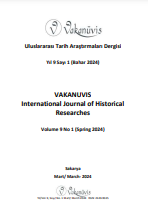XVIII. Yüzyıl Amasya’sında Hukuk, Kadın ve Şiddet
Law, Women and Violence in Eighteenth Century Amasya
Author(s): Merve KarakulakSubject(s): Gender Studies, History of Law, Social history, Studies in violence and power, 19th Century
Published by: Serkan YAZICI
Keywords: Violance; women; Legal register (şer’iyye sicili/Kadı register); Amasya;
Summary/Abstract: Ottoman society’s perspective on women and legal practices regarding women were determined by two main traditions: Hanafi/Sunni school of law and Old Turkic law. The ancient Turkish social order and law ensured women’s social visibility and a balanced status in patriarchal society. When compared to Islamic law, it can be said that it is a more egalitarian model in terms of women’s status. The increasing influence of Islamic law in the Ottoman social order and state structure from the end of the fifteenth century also affected the status of women. Considering the differences between rural areas and cities in the context of social visibility, a certain regression can be mentioned, but women’s legal rights such as litigation, inheritance and divorce were systematically implemented. However, in the Ottoman social order, especially in Central Anatolian cities such as Amasya, which was chosen as the sample population in this study, the continuity of violence, regardless of class, status and identity, has become commonplace almost since the first quarter of the sixteenth century. Those who committed violence were given different names such as Celalis, mültezim, mutegallibe or notables, but those who were subjected to violence were the same social groups such as women, villagers and craftsmen. In this study, sample cases were selected from the case records kept in the Amasya court between 1750 and 1800, when normative law came into force. The incidents of violence that women were exposed to, regardless of their status, the difficulties they experienced in the face of these incidents (such as physical, psychological, sexual and economic) and the ways of coping with them were examined. In order to clarify the status of women in the social and cultural structure, civil law cases such as women’s property rights and inheritance sharing; The response of Ottoman local law to the violence they suffered from various aspects, from physical violence to sexual assault, and their struggle to seek their rights were discussed. The case in point women, who represent a fragile, vulnurable and victimized social group, deficiencies in practice are noticeable. The extent to which women can access the rights granted to them in theory and practical applications have been evaluated in the context of sample cases.
Journal: Vakanüvis- Uluslararası Tarih Araştırmaları Dergisi
- Issue Year: 9/2024
- Issue No: 1
- Page Range: 332-361
- Page Count: 30
- Language: Turkish

